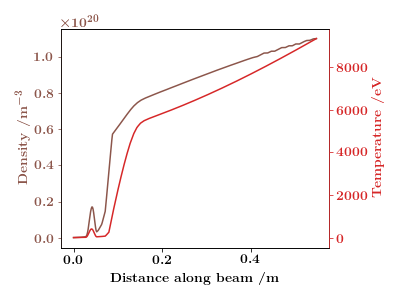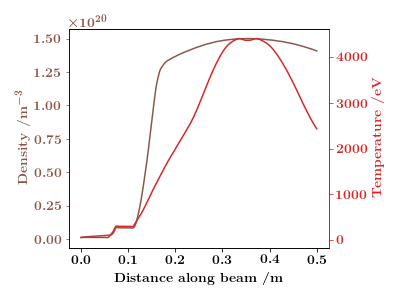Neutral Beam Penetration and Photoemission
Scope and motivation
This code comparison exercise is intended to assess the sensitivity of predictions of hydrogen beam penetration and of beam emissions in relevant fusion plasma conditions to different modelling codes and uncertainties in atomic data. It was conceived in order to support the aims of the Neutral Beams CRP which will provide evaluated and recommended data for the principal atomic processes relevant to heating and diagnostic neutral beams in fusion plasmas.
The workshop should bring together neutral beam modellers that may use a variety of atomic models and data. Relevant processes include excitation and deexcitation of beam neutrals by electron and ion impact (including impact by impurity ions), ionization from the ground state or from relevant excited states by electron and ion impact, and charge transfer resolved with respect to the excitation state of the pre-collision neutral H and the post-collision impurity ion. The comparison exercise will help modellers to identify possible errors in the atomic data and to identify important sensitivities of the simulations of beam penetration and beam-based emissions to uncertainties in the atomic data.
Workshop
A Workshop will be held in Debrecen, Hungary from 26 – 28 August 2019 to compare the results of this exercise. Remote participation will be possible, but researchers are encouraged to attend in person if at all possible.
Important Dates
| by 20 August 2019 | Upload test results and code description |
| 26 – 28 August 2019 | Code comparison workshop |
| 20 November 2019 | Completion of comparison article |
Organizing Committee
- Christian HILL, IAEA
- Gergő POKOL, Institute of Nuclear Techniques, Budapest University of Technology and Economics, Hungary
- Károly TŐKÉSI, Institute for Nuclear Research, Hungarian Academy of Sciences (ATOMKI), Debrecen, Hungary
- Oleksandr MARCHUK, Forschungszentrum Jülich, Germany
Test cases
Details of the test cases are available as an Excel chart and also for download from a shared Google drive folder. They involve H, D, He, and (optionally) Li and Na, at beam energies of 30, 100 and 1000 keV and plasma conditions representative of those present in fusion devices. To facilitate effective benchmarking, a constant plasma profile is considered. However, additional, three sets of variable conditions of temperature and density along the beam are be provided for optional consideration:
ITER_134000_5.txt: ITER scenariofluct_ITER_134000_5.txt: ITER scenario with a single temperature/density fluctuationisland_divertor.txt: Density and temperature profiles based on W7-X island divertor high density scenario taken at midplane bean shape cross section.



Agenda
Monday, 26 August 2019
Session 1: Local organising session
| 12:00 – 13:00 | Lunch |
| 13:00 – 18:00 | Working session and meeting coordination |
| 19:00 – 21:00 | Dinner |
Tuesday, 27 August 2019
| 09:00 – 09:15 | Károly TŐKÉSI (ATOMKI) and Christian HILL (IAEA): Opening, presentation of goals |
Session 2: Presentation of the participating codes and results
Details of the videoconferencing settings required for remote contribution have been emailed to the participants. Technical details of the H.323 configuration required can be found here.
Chair: Károly TŐKÉSI
| 09:15 – 09:40 | Örs ASZTALOS (Institute of Nuclear Techniques, Budapest University of Technology and Economics, Hungary) RENATE: A fluctuation BES synthetic diagnostic |
| 09:40 – 10:05 | Péter Zsolt PÖLÖSKEI (Max Planck Institute for Plasma Physics, Garching, Germany) FIDASIM and the Collisional Radiative Model |
| 10:05 – 10:30 | Jari VARJE (Aalto University, Finland) BBNBI benchmarks |
| 10:30 – 10:45 | Coffee Break |
| 10:45 – 11:00 | Manfred VON HELLERMANN Simulation of Spectra (SOS) Presented by Gergő POKOL |
| 11:00 – 11:30 | Martin O'MULLANE (Department of Physics, University of Strathclyde, United Kingdom) ADAS beam population – a sensitivity study [presentation (pdf: 944.0 KB)] |
| 11:30 – 12:00 | Oleksandr MARCHUK (Forschungszentrum Jülich (FZJ), Germany) Collisional Radiative Model: A statistical model |
| 12:00 – 14:00 | Lunch |
| 14:00 – 14:30 | Gergő POKOL (Institute of Nuclear Techniques, Budapest University of Technology and Economics, Hungary) Neutral Beam Penetration and Photoemission Benchmarks [presentation (pdf: 1012.9 KB)] |
| 14:30 – 15:30 | Discussion (all): Discussion of comparisons |
| 15:30 – 16:30 | Coffee Break |
| 16:30 – 18:00 | Local working session |
| 19:00 – 21:00 | Dinner |
Wednesday, 28 August 2019
Session 3: Conclusions and Further Work
Chair: Gergő POKOL
| 09:00 – 10:00 | Discussion (all): Conclusions of the benchmark results, remote closing |
| 10:00 – 12:00 | Local working session |
| 12:00 – 12:30 | Local closing |
Participants
13 participants from 6 countries.
| Christian HILL | IAEA | ||
| Sa‘ed AL-ATAWNEH | HUN-REN Institute for Nuclear Research (ATOMKI), Hungary | ||
| Jari VARJE | Aalto University, Finland | ||
| Oleksandr MARCHUK | Forschungszentrum Jülich (FZJ), Germany | ||
| Jinil CHUNG | Korea Institute of Fusion Energy, South Korea | ||
| Ismanuel RABADÁN | Department of Chemistry, Universidad Autónoma de Madrid, Spain | ||
| Gergő POKOL | Institute of Nuclear Techniques, Budapest University of Technology and Economics, Hungary | ||
| Károly TŐKÉSI | HUN-REN Institute for Nuclear Research (ATOMKI), Hungary | ||
| Martin O'MULLANE | Department of Physics, University of Strathclyde, United Kingdom | ||
| Manfred VON HELLERMANN | |||
| Taina KURKI-SUONIO | Aalto University, Finland | ||
| Örs ASZTALOS | Institute of Nuclear Techniques, Budapest University of Technology and Economics, Hungary | ||
| Péter Zsolt PÖLÖSKEI | Max Planck Institute for Plasma Physics, Garching, Germany |
Presentations
Örs ASZTALOS (Institute of Nuclear Techniques, Budapest University of Technology and Economics, Hungary)
RENATE: A fluctuation BES synthetic diagnostic
Oleksandr MARCHUK (Forschungszentrum Jülich (FZJ), Germany)
Collisional Radiative Model: A statistical model
Martin O'MULLANE (Department of Physics, University of Strathclyde, United Kingdom)
ADAS beam population – a sensitivity study
[presentation (pdf: 944.0 KB)]
Gergő POKOL (Institute of Nuclear Techniques, Budapest University of Technology and Economics, Hungary)
Neutral Beam Penetration and Photoemission Benchmarks
[presentation (pdf: 1012.9 KB)]
Péter Zsolt PÖLÖSKEI (Max Planck Institute for Plasma Physics, Garching, Germany)
FIDASIM and the Collisional Radiative Model
Jari VARJE (Aalto University, Finland)
BBNBI benchmarks
Manfred VON HELLERMANN
Simulation of Spectra (SOS)
Presented by Gergő POKOL